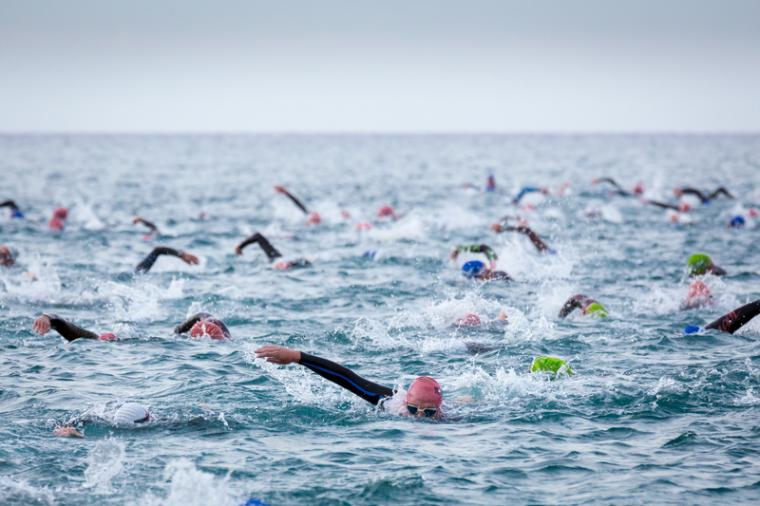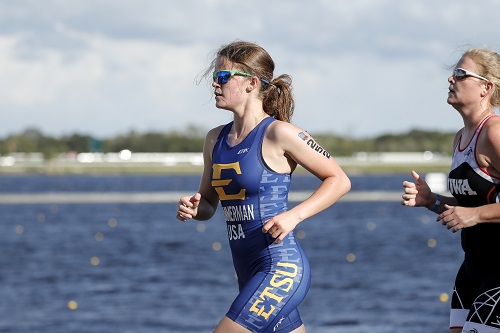

The varsity women’s collegiate triathlon series began in early September with high hopes that 2021 might finally be the year that triathlon becomes a full-fledged NCAA Championship sport. In fact, the finish line is so close that USA Triathlon officials are antsy to cross it.
“It’s what I lose sleep over,” Tim Yount, the organization’s Chief Sport Development Officer, told SDM this spring. “Not a night goes by that I don’t think about getting to 40 programs, at which point we will achieve full NCAA Championship status. We were really lucky and got six additions during the pandemic. Unfortunately, we lost our fall season. The energy and excitement are still there, though. We have 30 potential programs in the works; two are ready to be added and another four to five could get there as well. We are really confident about it.”
Indeed, the NCAA designated triathlon as an Emerging Sport for Women in 2014, giving it a 10-year window to demonstrate sustainability by recruiting 40 schools by 2024. As of Sept. 6, USA Triathlon reported that there are 37 (!) college programs now active. More than two thirds of them are Division II and III institutions. (See complete list below.)
“This is an exciting time in women’s collegiate triathlon,” Jenny Garrison, President of the College Triathlon Coaches Association, said. “We are approaching the precipice of becoming an NCAA Championship sport, and our athletes are more eager than ever to race after persevering through the challenges of 2020.”
As a replacement for the canceled 2020 women’s collegiate triathlon season, USA Triathlon held an abbreviated spring 2021 season that included the Clermont Draft-Legal Challenge (Clermont, Fla.), the Sarasota-Bradenton Triathlon (Sarasota, Fla.) and the Hyco Lake Triathlon (Semora, N.C.). While those events provided an opportunity for regional and national competition between varsity teams, they did not serve as qualifiers for the fall 2021 National Championships.
The schedule is back to normal this season, and the top eight NCAA varsity teams in Division I, II and III will qualify for the Women’s Collegiate Triathlon National Championships at Arizona State University in Tempe, Ariz., on Nov. 13.
“There’s still that last little bit,” Arizona State triathlon coach Cliff English told azcentral.com, referring to the final three institutions needed to reach Championship sport status. “We want to be part of the NCAA program and make sure we see this through.”
The sport also is getting a bump from the Olympics. Gwen Jorgensen won a triathlon gold medal for the United States in 2016 in Rio, and U.S. triathlete Katie Zaferes brought home the bronze from the Tokyo Games this year. Also, Team USA took second in the Olympics’ new mixed relay format in Tokyo. According to triathlon.org, in a team mixed relay format, “athletes must complete a super-sprint triathlon — 300-meter swim, 6.6-kilometer bike and 1-kilometer run — before tagging off to a teammate, always in the order female-male-female-male.”
“Triathlon was first included in the Olympics in Sydney in 2000,” Yount told SDM. “We doubled our membership for 10 straight years after that. Who knows how big it can balloon this time?”
At this point, it’s only a matter of time before the goal of 40 women’s collegiate triathlon programs is met — more than two years ahead of the NCAA’s deadline. Keep an eye on the latest newcomers to the sport here.
Meanwhile, here is a list of the 37 colleges and universities that now offer varsity triathlon programs:
Division I (9)
• Arizona State University (Tempe, Ariz.)
• Delaware State University (Dover, Del.)
• East Tennessee State University (Johnson City, Tenn.)
• Hampton University (Hampton, Va.)
• Texas Christian University (Fort Worth, Texas)
• University of Denver (Denver, Colo.)
• University of San Francisco (San Francisco, Calif.)
• University of South Dakota (Vermillion, S.D.)
• Wagner College (Staten Island, N.Y.)
Division II (16)
• American International College (Springfield, Mass.)
• Belmont Abbey College (Belmont, N.C.)
• Black Hills State University (Spearfish, S.D.)
• Colorado Mesa University (Grand Junction, Colo.)
• Concordia University Wisconsin (Mequon, Wis.)
• Daemen College (Amherst, N.Y.)
• Davis & Elkins College (Elkins, W. Va.)
• Drury University (Springfield, Mo.)
• Emmanuel College (Franklin Springs, Ga.)
• King University (Bristol, Tenn.)
• Lenoir-Rhyne University (Hickory, N.C.)
• Montana State University Billings (Billings, Mont.)
• Newberry College (Newberry, S.C.)
• Queens University of Charlotte (Charlotte, N.C.)
• St. Thomas Aquinas College (Sparkill, N.Y.)
• Wingate University (Wingate, N.C.)
Division III (12)
• Alvernia University (Reading, Pa.)
• Calvin University (Grand Rapids, Mich.)
• Central College (Pella, Iowa)
• Coe College (Cedar Rapids, Iowa)
• Eastern Mennonite University (Harrisonburg, Va.)
• Guilford College (Greensboro, N.C.)
• Millikin University (Decatur, Ill.)
• North Central College (Naperville, Ill.)
• Northern Vermont University (Johnson, Vt.)
• Transylvania University (Lexington, Ky.)
• Trine University (Angola, Ind.)
• Willamette University (Salem, Ore.)
“The sport is one of the most affordable for schools to add,” Yount said, also noting that interest in running and biking spiked in 2020 as people sought individual and socially distant ways to be active. “You had people saying, ‘Let’s go for a walk with the dog,’ and that became a natural evolution to do other things outside.”

